Text
Enter Black Panther
Jack Kirby’s support of civil rights is very commendable, especially considering how it affected the comic book industry. The best example was when Jack Kirby created Black Panther, who thanks to the recent Marvel movies including Captain America: Civil War, Avengers Infinity War and Endgame, and the movie Black Panther, has grown in popularity. When he was created, T’Chala (the Black Panthers identity) became the wealthiest fictional character in comics, inheriting the title as king of Wakanda from his father T’Chaka. The country of Wakanda is described in the comics as “the only African country that was never colonized,” and even though many have tried, due to no outside forces interfering it has managed to use it’s own resources to flourish into what’s considered to be one of the most advanced and wealthy fictional nations in comics. One reason behind the creation of Black Panther according to Kirby was, “I came up with the Black Panther because I realized I had no blacks in my strip…I had a lot of black readers. My first friend was…black! And here I was ignoring them because I was associating with everybody else.” Black Panther was released to the public with massive success and did something thing many comics at the time that would feature Black characters didn’t do, which was portraying black people as more than just the stereotypes which they were portrayed with and making the fictional African land of Wakanda a utopia of sorts, which broke many social barriers and broke many social barriers. It is nothing short of impressive.
Source:
https://www.history.com/news/the-real-history-behind-the-black-panther
0 notes
Text
Jack Kirby in the Beginning
In the beginning Jack Kirby was Born in the Lower East Side of New York City August 28, 1917 to parents Rose and Ben Kurtzberg. Since he was growing up during the great depression, schooling was very limited, in fact aside from Pratt which he proceeded to drop out the very next day do to his family not having enough money to pay for the education, he didn’t actually go to school. Instead, Jack Kirby learned from anyone he thought he could learn from whether it was his parents or neighbor, but when it came to art, he taught himself that almost entirely, and was inspired back newspaper comics like Flash Gordon. Even as a kid he was a prolific drawer that at the age of 16, he got a job working at Max Fleischer’s Animation studio on cartoons such as Betty Boop and Popeye the Sailor Man. Ultimately this was short lived due to employees going on strike and so he left and began working as a newspaper cartoonist. Finally, Jack Kirby enters the world of superhero comics when he began working for Victor Fox who created The Blue Beetle and alongside Bill Everett, created Sub-Mariner, but in 1941 would form a partnership with Joe Simon and was then hired to work the newly formed Timely Comics Company or as we now call it, Marvel Comics. Soon Jack would earn his title as “The King” after working for Marvel for several years and along with many people including Stan Lee in creating what we currently know as the Marvel Comics Universe.
Source:
https://kirbymuseum.org/biography/
0 notes
Text
The Legal Dispute Between Marvel/Disney and the Kirby Estate
Interestingly, in 2014, there was a legal disput that was settled between the Kirby family estate and Marvel, which at the time was recently purchased by Disney, over the copyright ownership of comic characters the Jack Kirby created and co-created. Apparently this legal dispute had gone on since 2009 and at first seemed to be mostly in Disney’s favor around 2011 when a federal judge said that "Kirby's contributions to Marvel between 1959 and 1963 were "work for hire," and therefore not subject to copyright termination.” This would later see some push back after a petition was released by Jack Kirby’s family and received support from multiple other petitioners, Bruce Lehman who was the former director of the U.S. Patent and Trademark Office at the time and a few other organizations including the WGA and DGA. This case almost went to the supreme court and honestly it’s hard to say who would have won the case if it did go to the supreme court.
Sources:
https://deadline.com/2014/09/jack-kirby-marvel-settlement-lawsuit-supreme-court-hearing-841711/
https://www.cbr.com/marvel-jack-kirby-family-settle-long-running-legal-dispute/
0 notes
Text
Kirby at DC comics
Surprisingly, Jack Kirby working at DC mentioned as much as I thought. Mostly because of all the work he did at Marvel, but even so, his contribution to DC comics is something incredible and noteworthy. Jack may have worked at Marvel the longest, but eventually, he decided that due to a lack of creative freedom, it was time he left for something different and was offered an editorial position at DC from Carmine Infantino who was the editorial director at the time. When Jack Kirby left Marvel for DC, he began working on the Jimmy Olsen comic book series. He then finally began to get to work on creating his new series, The Fourth World which would also lead towards him working on The New Gods, The Forever People, Mr. Miracle, and DC’s first black and white comics magazines Spirit World and In The Days Of The Mob. While working on The New Gods, The Forever People, and Mr. Miracle, Jack Kirby then created one of, if not the biggest comic book villain Darkeid, who is connected to all of them and is a huge mainstay in the DC comics universe. His contract only lasted until 1975 to which he then decided to return to Marvel instead of continue with DC.
Sources:
https://kirbymuseum.org/biography/
https://www.britannica.com/biography/Jack-Kirby
0 notes
Text
The time Kirby liberated a concentration camp
By far one of the worst moments in human history was the Holocaust. About roughly 15 million people were mass murdered in concentration camps where they were worked to the bone, malnourished, sick, and beaten to death. And the only reason the Nazi’s had was because of who they are. Those who were targeted were homosexuals, gypsies, mentally disabled, and many more, but the ones who got the worst of it were the Jews, of which 6 million where mass murdered. These concentration camps were spread out all over Europe and kept hidden, but Jack Kirby not only found one, he helped liberate it.
He discovered the camp while doing scouting for his regiment in Europe. His recount of the event is quoted in the article as followed. “There were mostly women and some men; they looked like they hadn’t eaten for I don’t know how long. They were scrawny. Their clothes were all tattered and dirty. The Germans didn’t give a s*** for anything. They just left the place; just like leaving a dog behind to starve. I was standing there for a long time just watching thinking to myself, ‘What do I do?’ Just thinking about it makes my stomach turn. All I could say was, ‘Oh, God.’” It was this event and other experiences during World War 2 that when he finally came home from the war and went back to working in comics, that would become the inspiration and origin story for one of the most famous X-Men characters, Magneto, who he himself is a Holocaust survivor. To think about what must’ve gone through Kirby’s head in that moment is something hard to imagine, especially since he himself is a Jew.
Source:
https://www.jwv.org/infinity-war-and-the-jewish-military-hero-that-made-it-all-possible/
0 notes
Text
Kirby’s personal experience
If you think Jack Kirby did not see or go through much action during the second world war, then you are dead wrong. If anything, it would not be entirely inaccurate to say he, like most veterans of the war, was incredibly lucky to survive, especially considered he’s survived around 36 assault attempts by the Nazi’s while in Northern France. During one of these assaults, the article mentions how Jack Kirby survived almost getting ran over by a German tank. The article says, “a large tank that smashed through the regiment’s defensive line, only to be stopped by an unnamed soldier managing to shoot through the driver’s viewing slit, killing him instantly and potentially saving the life of Kirby who was only feet away from its treads in a foxhole.” This feels like something that to an average person would be from a scene in a movie. Although Saving Private Ryan does something similar towards the end when Tom Hanks half dead and a German tank is slowly driving over a bridge towards him.
This man has clearly been through hell, but aside From that, another crazy moment that occurred was when he got into a fight with a German soldier. He has been quoted in an interview saying, “Well, let me say that guys are guys no matter what the circumstances may be and different rules apply. We called each other names all the time; we were cursing each other in English, German, French, Hebrew; I had quite a large vocabulary by the time I got back—I could cuss somebody out in four different languages. Sometimes a shot was never fired but we’d still be yelling at each other to ‘go to hell’ or ‘go sh*t on yourself’; but you never said anything about somebody’s mother, not unless you wanted somebody to take a potshot at you.” I guess it’s safe to say that Kirby, like Captain America, punched a Nazi in the face.
Source:
http://www.todayifoundout.com/index.php/2015/08/wwii-creator-captain-america/
0 notes
Video
youtube
Jack Kirby at War
This is just a small part of a one hour plus interview with Jack Kirby. In this short video, he vividly describes his experience in the second world war with scary details. He mentions in the video how during an assault, he was very lucky to be alive and would see his fellow brothers in arms quickly become “a red smear on a wall”.
Source:
https://www.youtube.com/watch?v=866ToIkLksA
0 notes
Text
Kirby Entering the War
Not many people today know about Jack Kirby’s time in the military during the second world war, which is kind of a shame since it’s actually really interesting, and the things he’s both seen and done in the war is also noteworthy. It all starts in 1943 when Kirby along with Joe Simon both got the call to action to fight in the World War 2 and was originally trained to be a combat engineer, although according to Jack Kirby’s son Neal, Jack wasn’t really knowledgeable in engineering, nor good apparently because he said that Jack “spent as much of his training as possible lying below a truck and occasionally smacking it with a wrench so that it sounded like he was doing something.”
After Basic training, Jack and Simon were both shipped overseas, although under different units, with Jack serving in Burma, which is Myanmar today and was trained to become an anti-aircraft gunner. Although this did not last because according to military records, he and his crew were bad enough that they would accidently shoot down friendly planes. It should be noted that these were live fire exercises he was put in so when he shot a friendly plane down, the pilot would have to bailout of the plane. Due his poor performance he was then relocated to the 11th infantry regiment, 5th division, 3rd army under George S. Patton, in Eastern Europe, to which he would fight on as a scout for his regiment, thanks to his Lieutenant learned he was the man that created and drew Captain America. Thanks to his time and service during the war, the things he saw and witnessed helped inspire a lot of the characters that he’s created and has helped made a huge impact on his comics as a whole.
Source:
http://www.todayifoundout.com/index.php/2015/08/wwii-creator-captain-america/
0 notes
Video
youtube
How Jack Kirby Left Marvel For DC And Created The Fourth World Pt. 1
The video by SYFY WIRE is just part 1 of how Jack Kirby left Marvel for DC to work on some of the most well known characters in the DC universe. The short documentary has speakers who have either known Jack Kirby and have even worked with him in the past. One of the people interviewed in the video was Mark Evanier who has worked with Kirby when he was still in New York and controversial inkier Mike Royer.
https://www.youtube.com/watch?v=omsyFsj2H78
0 notes
Text
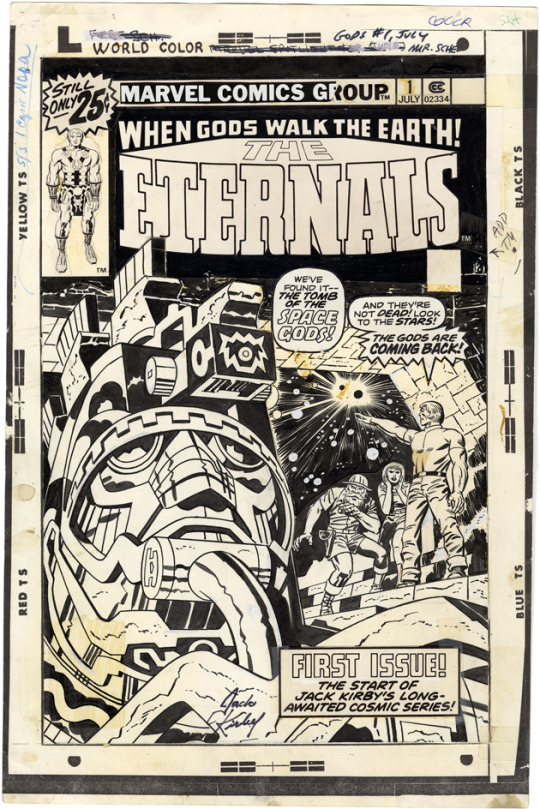
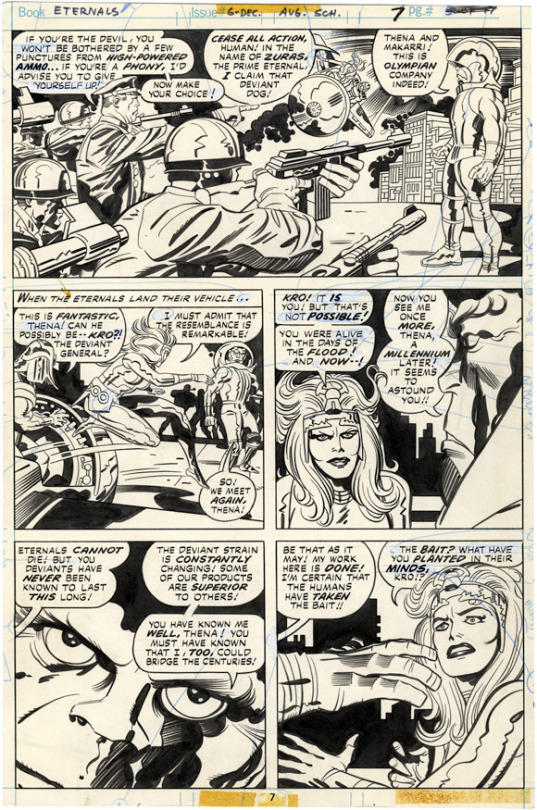



Illustrations from Jack Kirby's The Eternals. This comic series has recently scene a growth in popularity due Disney now working on a new Eternals movie. The comic had a curious upbringing.
The author also mentions that before this, Kirby was working at DC. He was working on a series titled New Gods and the Fourth World which had the same basic premis. It too was canceled before completion.
https://whatifkirby.com/gallery/comic-art-listings?comic-book-title=The+Eternals&issnum=&comic-art-type=All&period=All&inker=All&publisher=All&views_exposed_form_focused_field=
In the artical, the author writes, "Dubbed The Eternals, the series, which was also ultimately canceled before Kirby could end it on his own terms, laid the groundwork for much subsequent Marvel Comics mythology."
https://www.google.com/amp/s/nerdist.com/article/marvel-eternals-comic-book-history-origin-explainiac/%3famp
0 notes
Text

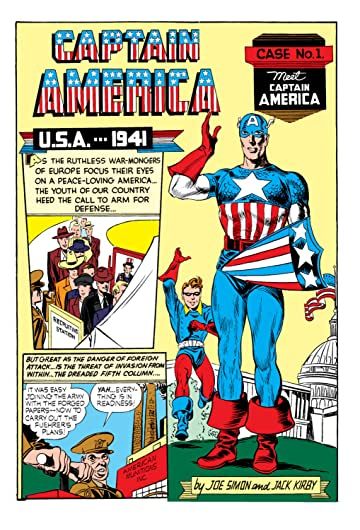
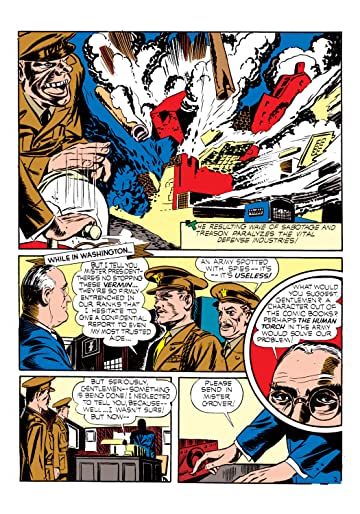
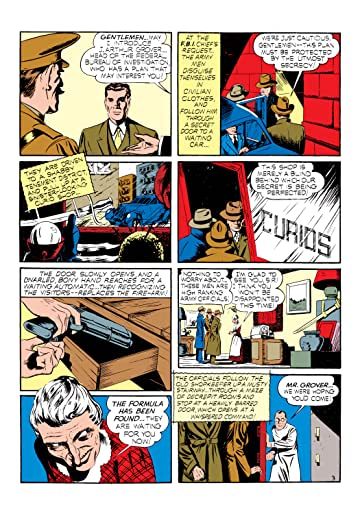

Cover and pages from Captain America issue #1 released in 1941. While many people now think Stab Lee created the first Avenger, it was actually Joe Simon and Jack Kirby and was released under Timely Comics, which was later changed to Marvel.
The auther Adam Bolloto writes, "His fist-based patriotism was a colossal hit with American comic readers – that first Captain America book sold nearly a million copies, and unlike most comic heroes at the time, Captain America didn’t start out as a side-story in a anthology series. His first appearance was all his, in "Captain America #1."
https://m.comixology.com/Captain-America-Comics-1941-1950-1/digital-comic/490
https://www.google.com/amp/s/filmschoolrejects.com/74-years-of-captain-america-a-history-of-marvels-america-iest-superhero-9ed077efb670/%3famp
0 notes
Text
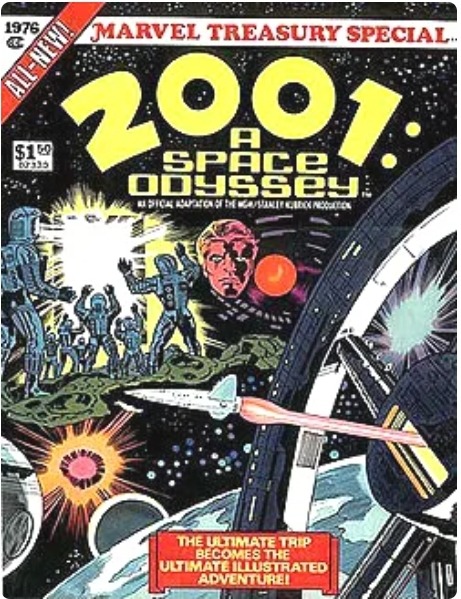
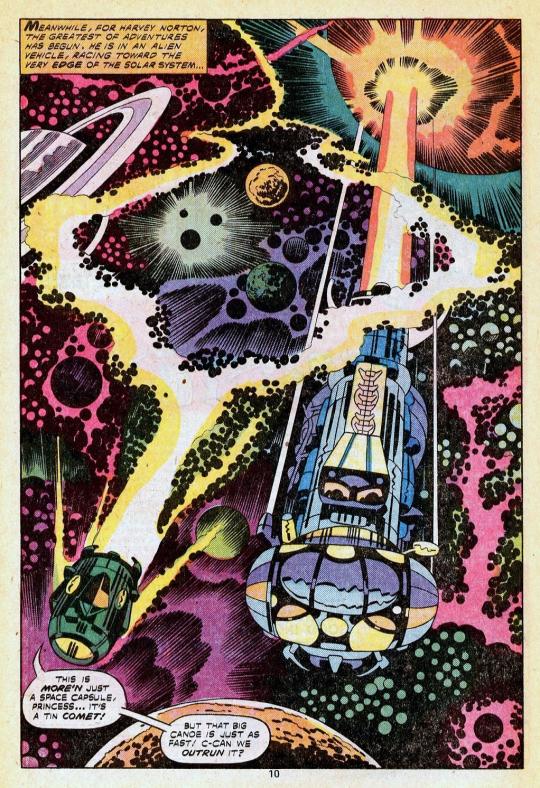
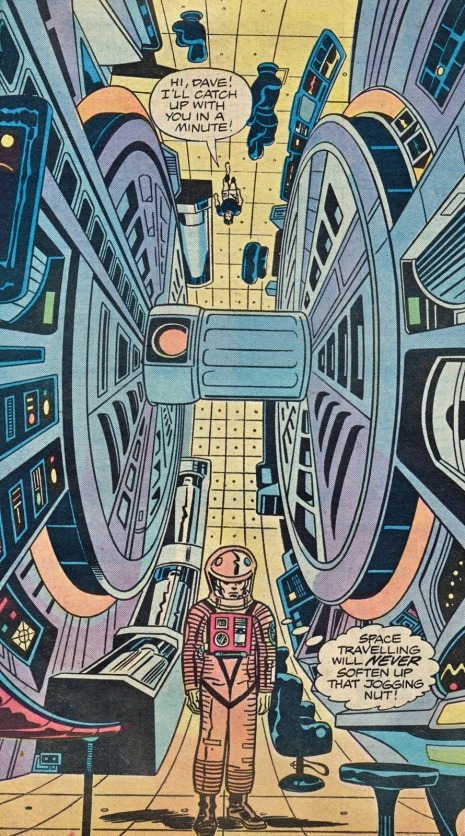
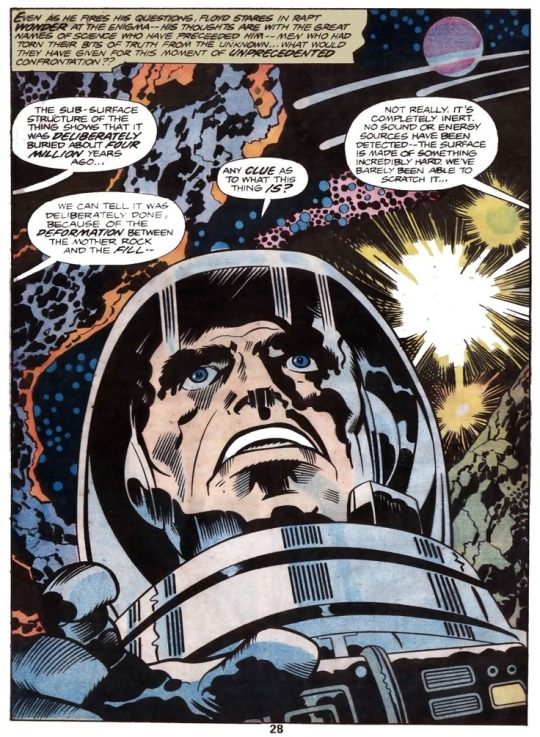
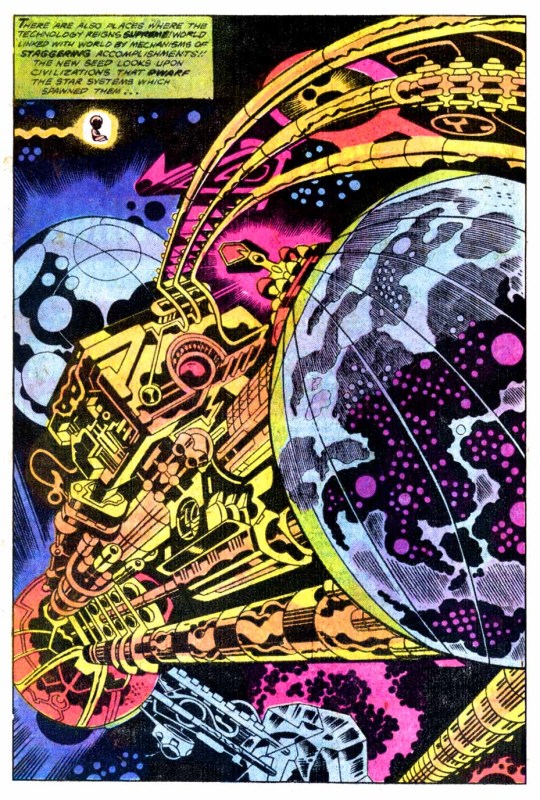
Someone who worked with Kirby on the series, Steve Sherman, has stated, "I remember one evening just sitting with him, and I’d just read the book Rendezvous With Rama. I’m sitting talking to Jack about flying saucers and things like that, and Jack always claimed he could see UFOs from his picture window in Thousand Oaks, and you’d believe it. And in the space of about 45 minutes, Jack’d come up with 13 different stories about flying saucers and people meeting them; an entire series."
https://dangerousminds.net/comments/2001_a_space_odyssey_by_jack_kirby
Pages and cover Kirby made from the 2001 A Space Odyssey comic series. This was one of Jack Kirby's Lesser known works.Because of Kirby's love for futuristic technology, this series was a perfect fit for him.
https://kirbymuseum.org/blogs/effect/
0 notes
Text


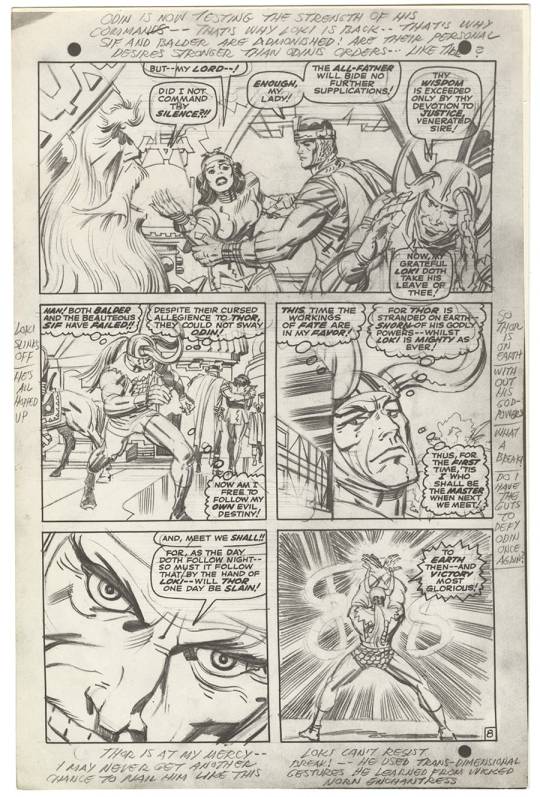


Jack Kirby's pencil of Thor #147 page 8.
This photoscan greatly gives us a perspective on the process of story telling through Kirby's penciling and the addition of dialogue. Whats especially cool is to see the notes made aren't just in the margins, but also in the panels. What's more surprising is how long Kirby spent working on these pages.
The author of the artical Robert Steibel explains, "Jack illustrated at least 10,000 pages in the 1960s so fans always talk about how “fast” Jack was, and he certainly was, but he still spent about 2 – 3 hours on each page, so illustrating 3 pages of story would take a full 8 – 9 hour shift at least. So, yeah, Jack was faster than an artist who spends a whole day laboring over a single page, but the guy was still working at a breakneck pace, sometimes 12-hours a day, 7-days a week if he was doing additional work."
http://www.tcj.com/a-96th-birthday/
0 notes
Text

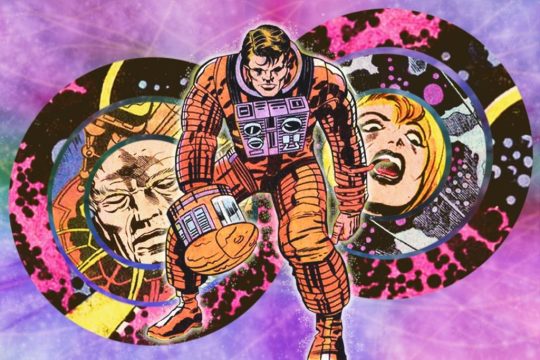
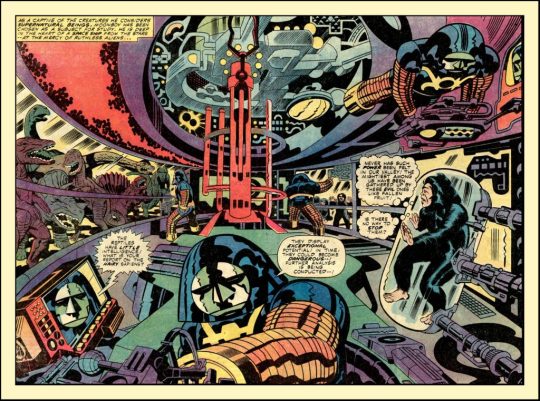

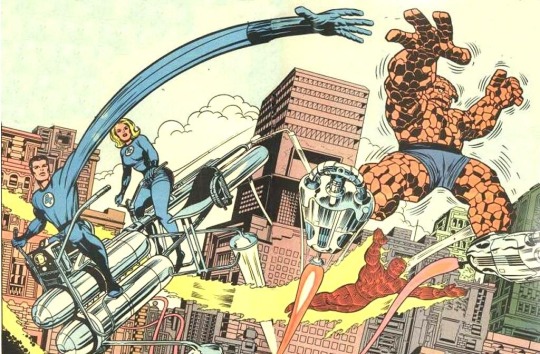
Jack Kirby comic illustratuons.
Jack Kirby being the prolific artist he is, was attentive to everything, even minor details, and was incrediby inventive with the application of futuristic technology. In comparison to other comics, his exploration with this made the worlds he worked on more unique.
Rosie Knight, the author of the artical, best desceibes Kirby's work as, "Worlds away from the blunt simplicity of most science fiction of the time, influencing generations of creators. His innovation wasn’t just confined to his content but also exhibited in the way he created art, experimenting with mixed media and photo collages, giving his cosmic work a surreal, otherworldly, and often abstract feel."
https://archive.nerdist.com/the-not-so-subtle-legacy-of-jack-kirby/
0 notes
Video
youtube
Jack Kirby interview on Entertainment Tonight on October 28, 1982.
https://youtu.be/v-BTa_lQ6uQ
0 notes
Photo

A photo of Jack Kirby working on a comic for Marvel taken either in the 1960′s or 70′s.
https://kirbymuseum.org/blogs/dynamics/2012/03/16/6615/
0 notes
Photo

A rare photo of Jack Kirby at boot camp in the year 1943 during World War 2.
https://www.todayifoundout.com/index.php/2015/08/wwii-creator-captain-america/
0 notes